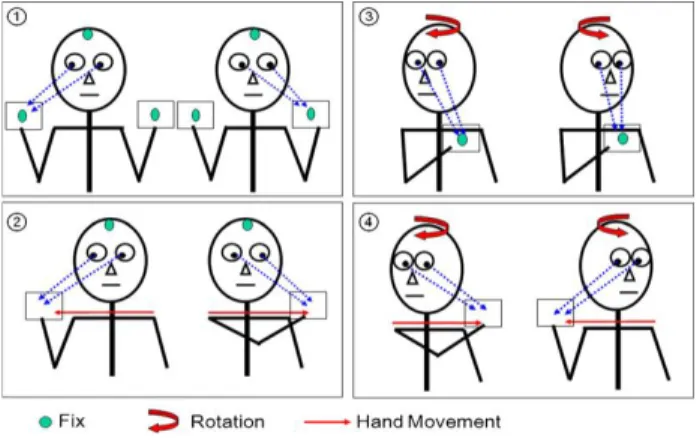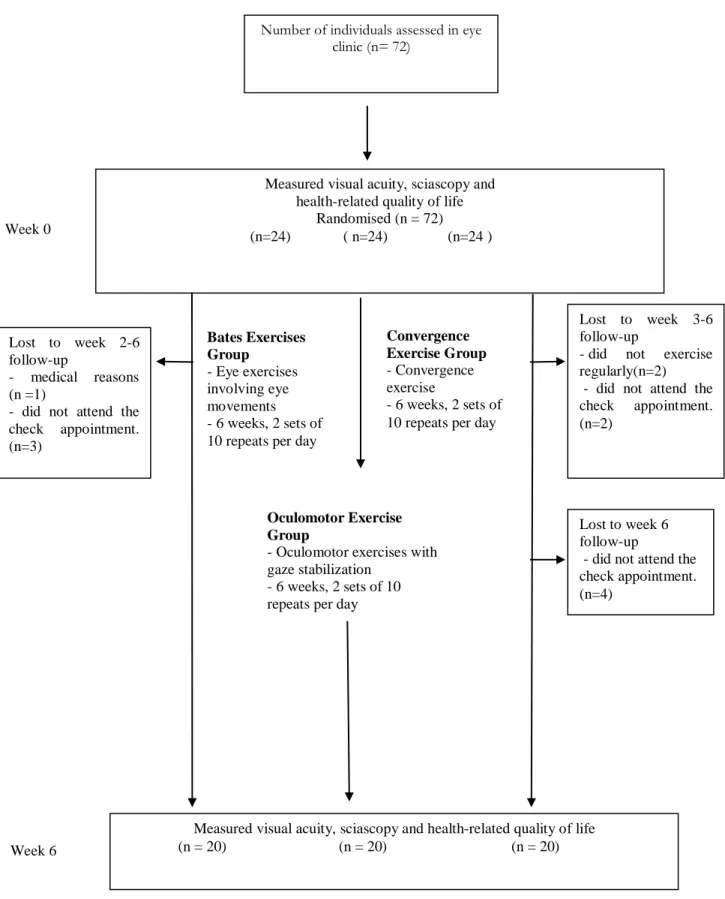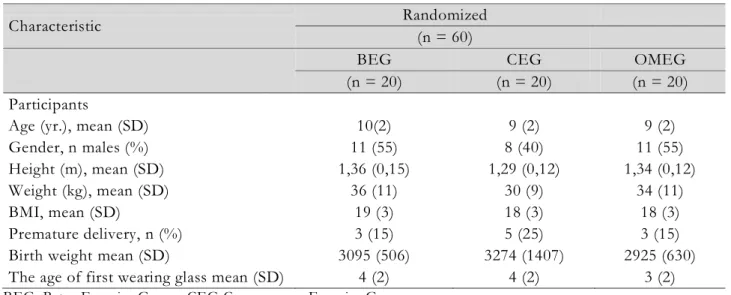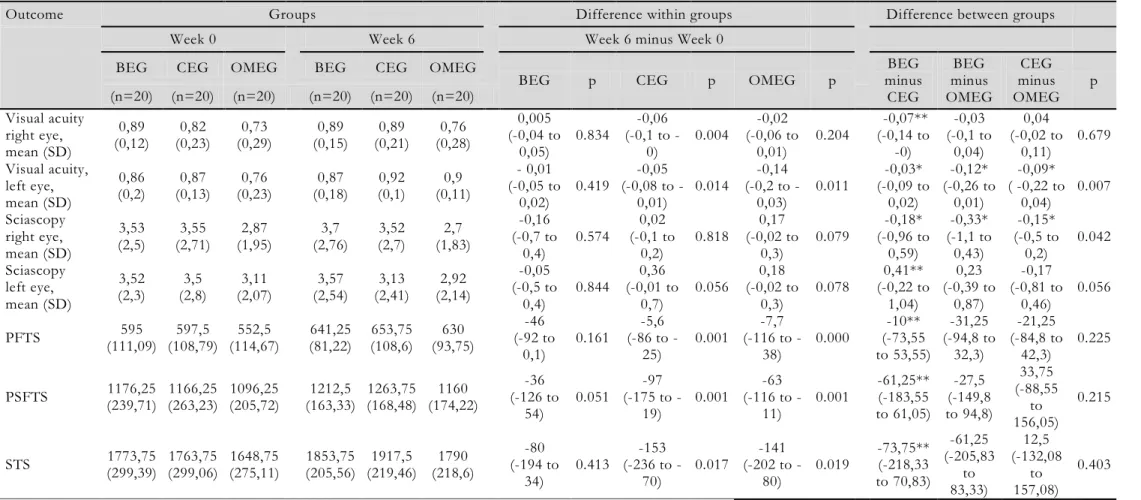East J Med 25(2): 234-240, 2020 DOI: 10.5505/ejm.2020.80774
Corresponding Author: Gulay Aras Bayram PT PhD, Faculty of Health Sciences, Physiotherapy and Rehabilitation, Istanbul Medipol ORIGINAL ARTICLE
Investigation of The Effect of Different Eye Exercises
on Hypermetropia in School-Aged Children: A
Randomized Single-Blind Trial
Gülay Aras Bayram1*, Işıl Kutlutürk Karagöz2
, Zeliha Candan Algun1
1 Medipol University, Department of Physiotherapy and Rehabilitation, Faculty of Health Sciences, Istanbul, Turkey 2Umraniye Research and Education Hospital, Health Science University, Istanbul, Turkey
Introduction
The World Health Organization (WHO) has reported that 43% of visual impairment is caused by uncorrected refractive errors (myopia, hypermetropia, astigmatism). A total of 19 million children under 15 years of age are blind and of whom 12 million are reported to result from untreated refractive errors (1). Refractive errors have been noted to be too frequent on eye screening of school-aged children in different provinces of Turkey. One study reported the prevalence of myopia was highest (2), while in another study the prevalence of astigmatism was found to be highest (3).
In 1920, W. H. Bates (4) puts forward that imperfect sight can be treated without the use of eyeglasses and suggested that eye exercises for perfect vision. To improve eyesight and prevent myopia, eye exercises were initiated in China in 1963, and since then, they have been being conducted in primary and secondary schools (5,6). Several cross-sectional studies have reported
changes in the prevalence of myopia in eye exercises doing individuals and emphasized the need for greater attention (7-9). Lin et al. (10) showed that eye exercises alleviated symptoms of near vision and these exercises have a protective effect for myopia. While their effect on the reduction of myopia was not striking, there are no studies in the literature about different eye exercises in hypermetropia patients.
The purpose of the present study is to determine whether Bates exercises, convergence, and oculomotor exercises have an effect on hypermetropia in the school-aged population and to find which of these exercises is superior to the others.
Materials and Methods
This randomized, single-blind, clinical trial was performed with a 6-week treatment period. This study was approved the non-intervention ethics committee. Informed written consent by following the Declaration of Helsinki was obtained from all
ABSTRACT
To investigate the effect of different eye exercises on hypermetropia in school -aged children and to determine whether exercise protocols have superiority to each other.
60 hypermetropia school-aged children were randomly assigned to three groups: Bates Exercise Group (BEG), Convergence Exercise Group (CEG) and Oculo-Motor Exercise Group (OMEG). Outcome measures included sciascopy, Snellen chart and The Pediatric Quality of Life Inventory Version 4.0(PedsQI4.0). All three groups were given home exercises which warranted eye exercises twice a day, repeated 10 times daily for 6 weeks.
CEG showed a statistically significant effect on visual acuity for the right and left eye (p=0.004, p=0.014, respectively) an d Pediatric Quality of Life Inventory (p<0.05). In the OMEG, there was a statistically significant effect on visual acuity for the left eye (p=0.011) and Pediatric Quality of Life Inventory (p<0.05).
Conclusion: Eye exercises, especially those such as convergence and oculomotor exercises could be reliab ly performed for the treatment of hypermetropia in school-aged children.
Fig. 1. Oculomotor exercises (17)
participants in the study. Participants were chosen from the school-aged children between 7 and 17 with hypermetropia presenting to the training and research hospital. Subjects who have cycloplegic refraction more than 2.00 D and need glasses with astigmatism less than -1.50 D in each eye and no history of any ocular or systemic diseases were included in the study. Spherical and astigmatic values obtained with a sciascopy were included in the study. Subjects who had eye surgery, strabismus and are unable to cooperate with exercise training were excluded from the study. A total of 60 patients were included in the study and randomized into 3 different exercise groups (n=20): Bates exercises group, the convergence exercise group, and the oculomotor exercise group. Randomization was performed according to the sequence of patients’ presentation to the hospital by a physiotherapist who applied exercise. The demographic data of the participants was obtained before randomization and the baseline medical assessments were made by a blind ophthalmologist. Exercises were explained to all participants and their parents by the same physiotherapist. Exercise booklets covering exercise protocols and exercise diaries were given to the participants. Once a week, it is made reminder phone calls to the patients. At the end of the 6th week, visual acuity, sciascopy, and Pediatric Quality of Life Inventory Version 4.0 (PedsQL 4.0) scores were recorded. Cycloplegic measurement was not performed in order to evaluate the effect of exercises on accommodation capacity.
The Bates Exercises Group (BEG): Based on W. Bates Method, a protocol involving 4-directional and circumduction movement of the eye was applied (4). The patients in the Bates exercises group (BEG) were prescribed a protocol which is home-based vision therapy including eye exercises 2 sets per day, each set 10 repeats for 6 weeks.
The Convergence Exercise Group (CEG):
Convergence exercises were performed with the protocol used for the study of Langer et al (10). The children in the group were given a convergence exercise protocol prepared as a home program exercises which are twice a day in the morning and in the evening for 5 minutes and during 6 weeks.
The Oculomotor Exercise Group (OMEG):
Oculomotor exercises were performed with the protocol used for the study of Morimoto et al. (11) (Figure 1). Four different oculomotor exercises were designed as a home program for the participants in the oculomotor exercise group. Exercises were performed 10 repetitions twice a day for 6 weeks.
Outcome Measures: The ophthalmologist used
the Snellen eye chart for measurement of visual acuity. In the measurement of visual acuity, individuals were evaluated with their glasses and right eye first. Hypermetropic measurements of the patients were taken with sciascopy. Health-related quality of life was assessed using the Pediatric Quality of Life Inventory Version 4.0 (PedsQL 4.0). Scores are calculated in three domains; a scale’s total score (STS), a physical functioning total score (PFTS) and the total psycho-social functioning total score (PSFTS) found by calculating emotional, social and school functioning scores (12). The same evaluations were repeated after the 6 weeks-exercise programs.
Data Analysis: The size of the sample in each
group for power analysis was found 20 participants with a 5% margin of error and the SPSS 18.0 statistical package program was used for statistical analyses. Data were expressed as mean, standard deviation, and percentages. The Shapiro-Wilk test showed the normal distribution for all variables. In-group and between-group differences were compared using the ANOVA test. Cohen's effect size was used to determine the power of the means. Levene’s test was used to test the homogeneity of the variances of the independent groups. Homogeneous and non-homogeneous variables were compared using the Tukey's HSD post hoc test and Tamhane's-T2 test, respectively. p-value of less than 0.05 was considered significant.
Results
The flow chart of the study is shown in Figure 2. The demographic characteristics of the
Week 0
Oculomotor Exercise Group
- Oculomotor exercises with gaze stabilization
- 6 weeks, 2 sets of 10 repeats per day
Fig. 2. Design and flow of participants through the trial
measurements are shown in Table 2. In the Bates exercise group, no statistical difference was seen in the visual acuity, sciascopy and PedsQL measurements (p>0.05), (Table 2).
The convergence exercise group (CEG), had a significant increase in the right and left eye visual acuity (p=0,004, p=0,014, respectively). It was shown that there was a difference in sciascopy but
Convergence Exercise Group
- Convergence exercise
- 6 weeks, 2 sets of 10 repeats per day Number of individuals assessed in eye
clinic (n= 72)
Measured visual acuity, sciascopy and health-related quality of life
Randomised (n = 72) (n=24) ( n=24) (n=24 ) Bates Exercises Group - Eye exercises involving eye movements - 6 weeks, 2 sets of 10 repeats per day
Week 6
Measured visual acuity, sciascopy and health-related quality of life (n = 20) (n = 20) (n = 20) Lost to week 2-6
follow-up
- medical reasons (n =1)
- did not attend the check appointment. (n=3)
Lost to week 3-6 follow-up
- did not exercise regularly(n=2) - did not attend the check appointment. (n=2)
Lost to week 6 follow-up
- did not attend the check appointment. (n=4)
Table 1. Baseline characteristics of the participants
Characteristic Randomized
(n = 60)
BEG CEG OMEG
(n = 20) (n = 20) (n = 20) Participants
Age (yr.), mean (SD) 10(2) 9 (2) 9 (2)
Gender, n males (%) 11 (55) 8 (40) 11 (55)
Height (m), mean (SD) 1,36 (0,15) 1,29 (0,12) 1,34 (0,12)
Weight (kg), mean (SD) 36 (11) 30 (9) 34 (11)
BMI, mean (SD) 19 (3) 18 (3) 18 (3)
Premature delivery, n (%) 3 (15) 5 (25) 3 (15)
Birth weight mean (SD) 3095 (506) 3274 (1407) 2925 (630) The age of first wearing glass mean (SD) 4 (2) 4 (2) 3 (2)
BEG: Bates Exercise Group, CEG Convergence Exercise Group, OMEG: Oculomotor Exercise Group, BMI: Body Mass Index
it was not statistically significant (p>0,05). There were improvements at statistical levels in PedsQL measurements (p<0.05), (Table 2).
The oculomotor exercise group (OMEG) had significant an increase in visual acuity in the left eye (p = 0.011). Statistically significant differences were determined in sciascopy, and PedsQL measurements (p<0.05), (Table 2).
The visual acuity of the left eye was different in inter-group comparisons in Anova (p=0,024, p=0,008). In the comparison between the groups (Table 2), it was determined that oculomotor exercises contributed the most to the visual acuity of the left eye (p = 0.006).
Discussion
In this randomized single-blind study in which 60 school-aged children (7-17 years) with hypermetropia were diagnosed, the effect of 3 different eye exercises on 6 weeks was examined. It has been determined that oculomotor exercises make a significant contribution to left eye visual acuity and quality of life. Convergence exercises have been shown to improve visual acuity in both eyes and contribution to the quality of life of children. It was determined that Bates exercises did not have any effect on visual acuity, sciascopy and quality of life.
In the literature, the studies using the Bates method show different result related to the contribution of the exercises to visual acuity and refractive errors (6,13,14). Li et al. (6) reported in myopic children who practice Chinese eye exercises, changes in the corrected near and far visual acuity did not have any
statistically significant consequences. Mohamed (13) determined that Bates exercises that were applied 6 weeks, improved the visual acuity of both eyes in adolescents with myopia. In other studies in which Bates exercises were performed, it was seen that there was no effect on visual acuity and refractive errors (14). In our study, it was found that Bates exercises did not contribute to the visual acuity and refractive errors.
In the literature, although the studies using convergence exercises in school children with hypermetropia are quite limited, Langer et al. (10) showed that convergence exercises improve visual acuity in healthy adults. In our study, the convergence exercise group had a significant increase in the right and left eye visual acuity. The improvement in visual acuity can be explained by improving the accommodation mechanism of the eye by following the results of previous studies (15-17).
Morimoto et al. (11) reported that oculomotor and gaze stability exercises performed for 3 weeks enhanced dynamic visual acuity in healthy adults. Head movements in oculomotor exercises have been explained to be effective in preserving and increasing visual acuity by stimulating vestibule-ocular reflex (18). It was also stated that the head movements in oculo-motor exercises create neural adaptations in the vestibular nucleus, stimulate the ocular reflexes and thus maintain and improve visual acuity (19,20). This mechanism of the effect of oculomotor exercises may explain the improvement in visual acuity of the left eye in our study.
In our study, the differences in hypermetropia values between pre- and post-treatment were determined especially in the left eye. Before the
Table 2. Mean (SD) of groups, mean (SD) difference within groups and mean (95% CI) differe nce between groups
Outcome Groups Difference within groups Difference between groups
Week 0 Week 6 Week 6 minus Week 0
BEG CEG OMEG BEG CEG OMEG BEG
p CEG p OMEG p minus BEG CEG BEG minus OMEG CEG minus OMEG p (n=20) (n=20) (n=20) (n=20) (n=20) (n=20) Visual acuity right eye, mean (SD) 0,89 (0,12) (0,23) 0,82 (0,29) 0,73 (0,15) 0,89 (0,21) 0,89 (0,28) 0,76 0,005 (-0,04 to 0,05) 0.834 -0,06 (0,1 to -0) 0.004 -0,02 (-0,06 to 0,01) 0.204 -0,07** (-0,14 to -0) -0,03 (-0,1 to 0,04) 0,04 (-0,02 to 0,11) 0.679 Visual acuity, left eye, mean (SD) 0,86 (0,2) (0,13) 0,87 (0,23) 0,76 (0,18) 0,87 (0,1) 0,92 (0,11) 0,9 - 0,01 (-0,05 to 0,02) 0.419 -0,05 (0,08 to -0,01) 0.014 -0,14 (0,2 to -0,03) 0.011 -0,03* (-0,09 to 0,02) -0,12* (-0,26 to 0,01) -0,09* ( -0,22 to 0,04) 0.007 Sciascopy right eye, mean (SD) 3,53 (2,5) (2,71) 3,55 (1,95) 2,87 (2,76) 3,7 (2,7) 3,52 (1,83) 2,7 -0,16 (-0,7 to 0,4) 0.574 0,02 (-0,1 to 0,2) 0.818 0,17 (-0,02 to 0,3) 0.079 -0,18* (-0,96 to 0,59) -0,33* (-1,1 to 0,43) -0,15* (-0,5 to 0,2) 0.042 Sciascopy left eye, mean (SD) 3,52 (2,3) (2,8) 3,5 (2,07) 3,11 (2,54) 3,57 (2,41) 3,13 (2,14) 2,92 -0,05 (-0,5 to 0,4) 0.844 0,36 (-0,01 to 0,7) 0.056 0,18 (-0,02 to 0,3) 0.078 0,41** (-0,22 to 1,04) 0,23 (-0,39 to 0,87) -0,17 (-0,81 to 0,46) 0.056 PFTS (111,09) 595 (108,79) 597,5 (114,67) 552,5 (81,22) 641,25 (108,6) 653,75 (93,75) 630 (-92 to -46 0,1) 0.161 -5,6 (86 to -25) 0.001 -7,7 (116 to -38) 0.000 -10** (-73,55 to 53,55) -31,25 (-94,8 to 32,3) -21,25 (-84,8 to 42,3) 0.225 PSFTS (239,71) 1176,25 (263,23) 1166,25 (205,72) 1096,25 (163,33) 1212,5 (168,48) 1263,75 (174,22) 1160 (-126 to -36 54) 0.051 -97 (175 to -19) 0.001 -63 (116 to -11) 0.001 -61,25** (-183,55 to 61,05) -27,5 (-149,8 to 94,8) 33,75 (-88,55 to 156,05) 0.215 STS (299,39) 1773,75 (299,06) 1763,75 (275,11) 1648,75 1853,75 (205,56) (219,46) 1917,5 (218,6) 1790 -80 (-194 to 34) 0.413 -153 (236 to -70) 0.017 -141 (202 to -80) 0.019 -73,75** (-218,33 to 70,83) -61,25 (-205,83 to 83,33) 12,5 (-132,08 to 157,08) 0.403
** Tukey's HSD post hoc test * Tamhane's T2 test
BEG: Bates Exercises Group, CEG: Convergence Exercise Group, OMEG: Oculomotor Exercise Group PFTS: Physical Functioning Total Score, PSFTS: Psycho-Social Functioning Total Score, STS:
Scale’s Total Score
treatment in the oculomotor group, left eye hypermetropia values were higher than the right eye. However, there was no statistically significant difference between the 3 groups in pretreatment values. At the end of 6th week, the change of hypermetropia in the left eye in the oculomotor group determined to be more than in the right eye. This measurable change is greater in the left eye than in the right eye. This result may suggest that the eye with refractive error is more responsive to oculomotor exercise therapy.
In our study, the effect of oculomotor exercises on visual acuity was found to be higher than the other two exercises. Studies with gaze stabilization exercises and oculomotor exercises alone and in combination with vestibular rehabilitation assessed the effect of vestibular exercises in hypofunction postural stability and reported satisfactory results (4,11,21). Visual input and eye movements in children have proved to be significant factors in maintaining postural stability (22-24). This result suggests that oculomotor exercises, a current hypermetropic defects can be used as a reserve for accommodation.
The association between the severity of visual impairment and the health-related quality of life is reported and the deterioration in visual acuity and visual field defect harm the quality of life of individuals (25-27). Our study found promising improvements in all parameters of the quality of life in the exercise groups (the CEG and the OMEG) in which visual acuity improved and the magnitude of hypermetropia began to decrease. The results of our study are compatible with the literature and indicate that exercises performed to the eye can contribute to the quality of life positively.
In summary in our study, oculomotor exercises, convergence exercises and Bates method were applied in the treatment of hypermetropia in school-aged children, their effectiveness and quality of life were evaluated. As a result of the evaluation, it was concluded that especially oculomotor and convergence exercises affected visual acuity and quality of life. However, the absence of a control group and the limited number of cases in our study can be considered as a limitation of the study. To obtain more reliable results, large scale and control group studies are needed to overcome the existing limitations.
References
1. World Health Organization (WHO). Obesity and
https://www.who.int/en/news-room/fact-sheets/detail/obesity-and-overweight. Accessed 8 March 2019
2. Gursoy H, Basmak H, Yaz Y, Colak E. Vision screening in children entering school: Eskisehir, Turkey. Ophthalmic epidemiology 2013; 20: 232-238.
3. Caca I, Cingu AK, Sahin A, et al. Amblyopia and Refractive Errors Among SchoolAged Children With Low Socioeconomic Status in Southeastern Turkey. J Pediatr Ophthalmol Strabismus 2013; 50: 37-43.
4. Bates WH. The Cure of Imperfect Sight by Treatment Without Glasses. New York City: Central Fixation. 1920.
5. Eye exercises. Available from: https://en.wikipedia.org/wiki/Eyes_exercise. Accessed 2 Sep 2017.
6. Li S-M, Kang M-T, Peng X-x, et al. Efficacy of Chinese eye exercises on reducing accommodative lag in school-aged children: a randomized controlled trial. PLoS One 2015; 10: e0117552. 7. Xie H, Xie Z, Zhou F, Hu L. Myopia prevalence
and influencing factor analysis of primary and middle school students in our country. Zhonghua yi xue za zhi 2013; 93: 999-1002.
8. Zhong P, Wang K, Zhang C. The epidemiological investigation of myopia in junior students. Qianwei Journal of Medicine 2004; 54.
9. Zhang D, Hui T. Study on the effect of attitude to eye exercise on vision. Chin J School Doctor 2006; 20: 501-503.
10. Langer E, Djikic M, Pirson M, Madenci A, Donohue R. Believing is seeing: Using mindlessness (mindfully) to improve visual acuity. Psychological Science 2010; 21: 661-666.
11. Morimoto H, Asai Y, Johnson EG, et al. Effect of oculo-motor and gaze stability exercises on postural stability and dynamic visual acuity in healthy young adults. Gait & posture 2011; 33: 600-603.
12. Varni JW, Seid M, Rode CA. The PedsQL™: measurement model for the pediatric quality of life inventory. Medical care 1999; 126-139. 13. Saar M. Vision Therapy-Based Program for
Myopia Control in Adolescents. Middle-East Journal of Scientific Research 2013; 13: 390-396. 14. Rathod VJ, Desai PD, Alagesan J. Effect of Eye
Exercises on Myopia-Randomized Controlled Study. Journal of Pharmaceutical and Biomedical Sciences (JPBMS) 2011; 10(12).
15. Trial T, Group S. The Convergence Insufficiency Treatment Trial: Design, Methods, and Baseline Data. Ophthalmic Epidemiology 2008; 15: 24. 16. Horwood A, Toor S. Clinical test responses to
different orthoptic exercise regimes in typical young adults. Ophthalmic and Physiological Optics 2014; 34: 250-262.
17. Horwood AM, Toor SS, Riddell PM. Change in convergence and accommodation after two weeks of eye exercises in typical young adults. Journal of American Association for Pediatric Ophthalmology and Strabismus 2014; 18: 162-168.
18. Hain TC, Helminski JO. Anatomy and physiology of the normal vestibular system. Vestibular rehabilitation 2007; 1: 2.
19. Miles F, Eighmy B. Long-term adaptive changes in primate vestibuloocular reflex. I. Behavioral observations. Journal of Neurophysiology 1980; 43: 1406-1425.
20. Miles F, Lisberger S. Plasticity in the vestibulo-ocular reflex: a new hypothesis. Annual review of neuroscience 1981; 4: 273-299.
21. Hall CD, Heusel-Gillig L, Tusa RJ, Herdman SJ. Efficacy of gaze stability exercises in older adults with dizziness. Journal of Neurologic Physical Therapy 2010; 34: 64-69.
22. Ajrezo L, Wiener-Vacher S, Bucci MP. Saccades improve postural control: a developmental study in normal children. PloS one 2013; 8: e81066.
23. Schärli AM, van de Langenberg R, Murer K, Müller R. Postural control and head stability during natural gaze behaviour in 6-to 12-year-old children. Experimental brain research 2013; 227: 523-534.
24. Bucci MP, Ajrezo L, Wiener-Vacher S. Oculomotor tasks affect differently postural control in healthy children. International Journal of Developmental Neuroscience 2015; 46: 1-6. 25. Khorrami-Nejad M, Sarabandi A, Akbari M-R,
Askarizadeh F. The impact of visual impairment on quality of life. Medical hypothesis, discovery and innovation in ophthalmology 2016; 5: 96. 26. Patino CM, Varma R, Azen SP, et al. The impact
of change in visual field on health-related quality of life: the Los Angeles Latino Eye Study. Ophthalmology 2011; 118: 1310-1317.
27. Park Y, Shin JA, Yang SW, Yim HW, Kim HS, Park Y-H. The relationship between visual impairment and health-related quality of life in Korean adults: The Korea national health and nutrition examination survey (2008-2012). PLoS One 2015; 10: e0132779.



